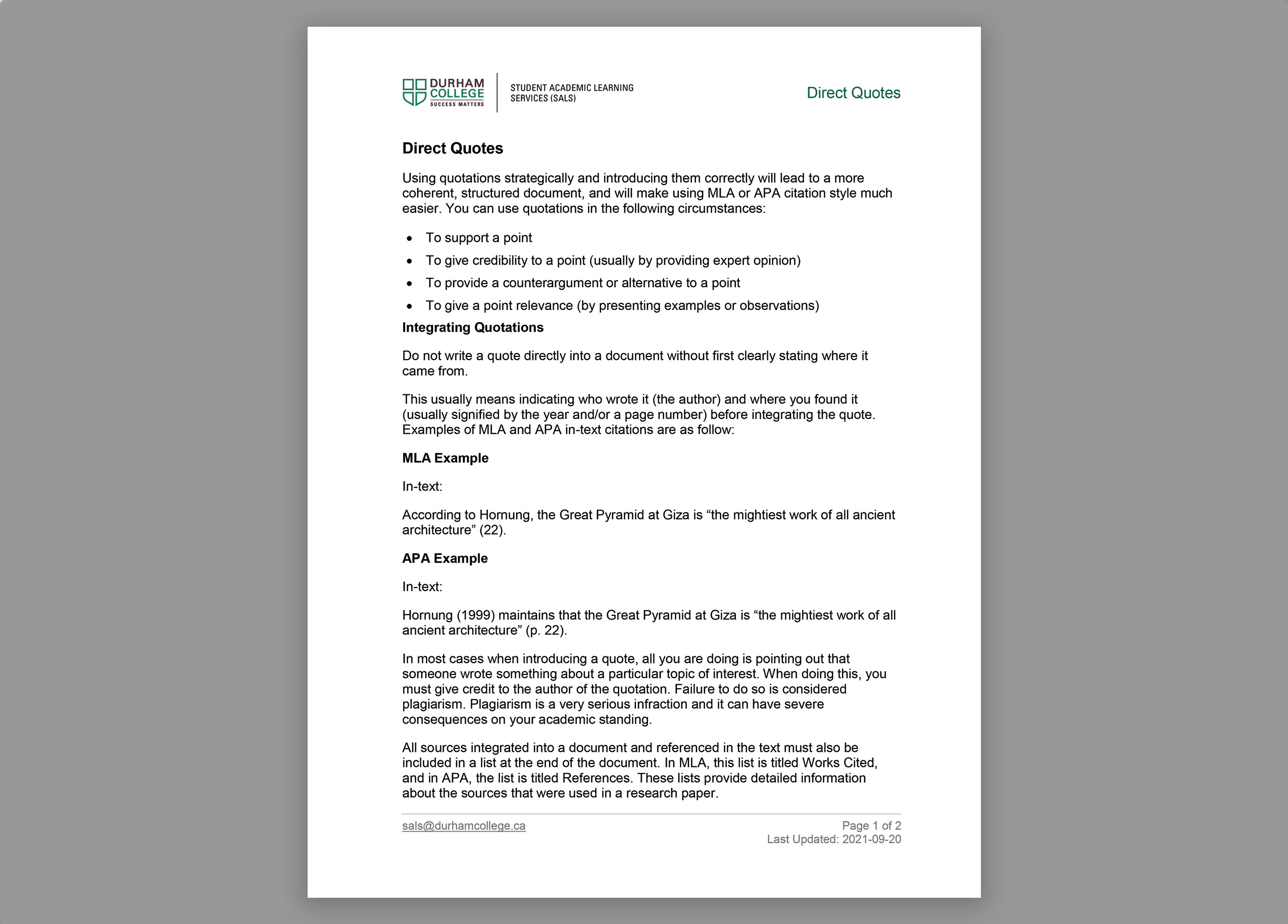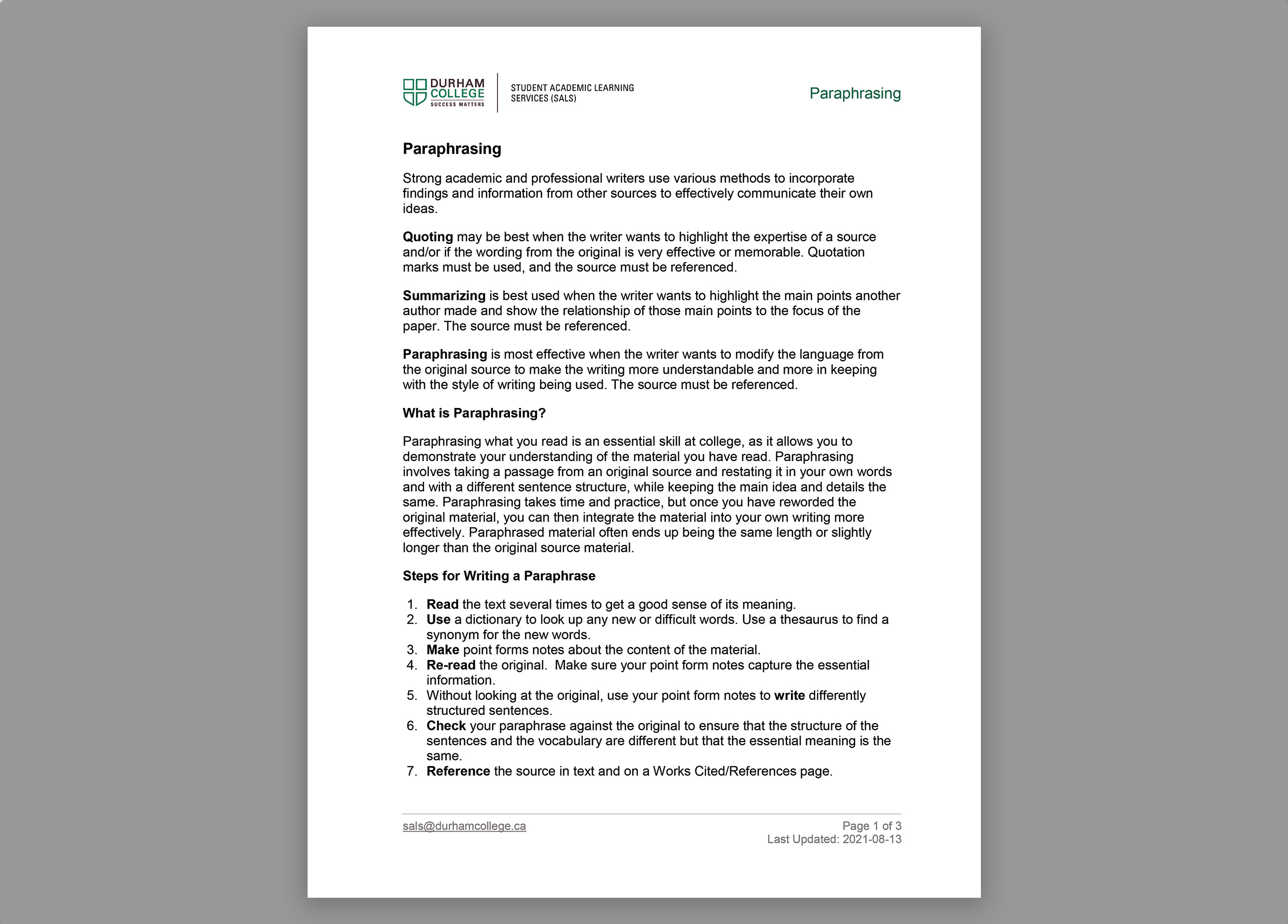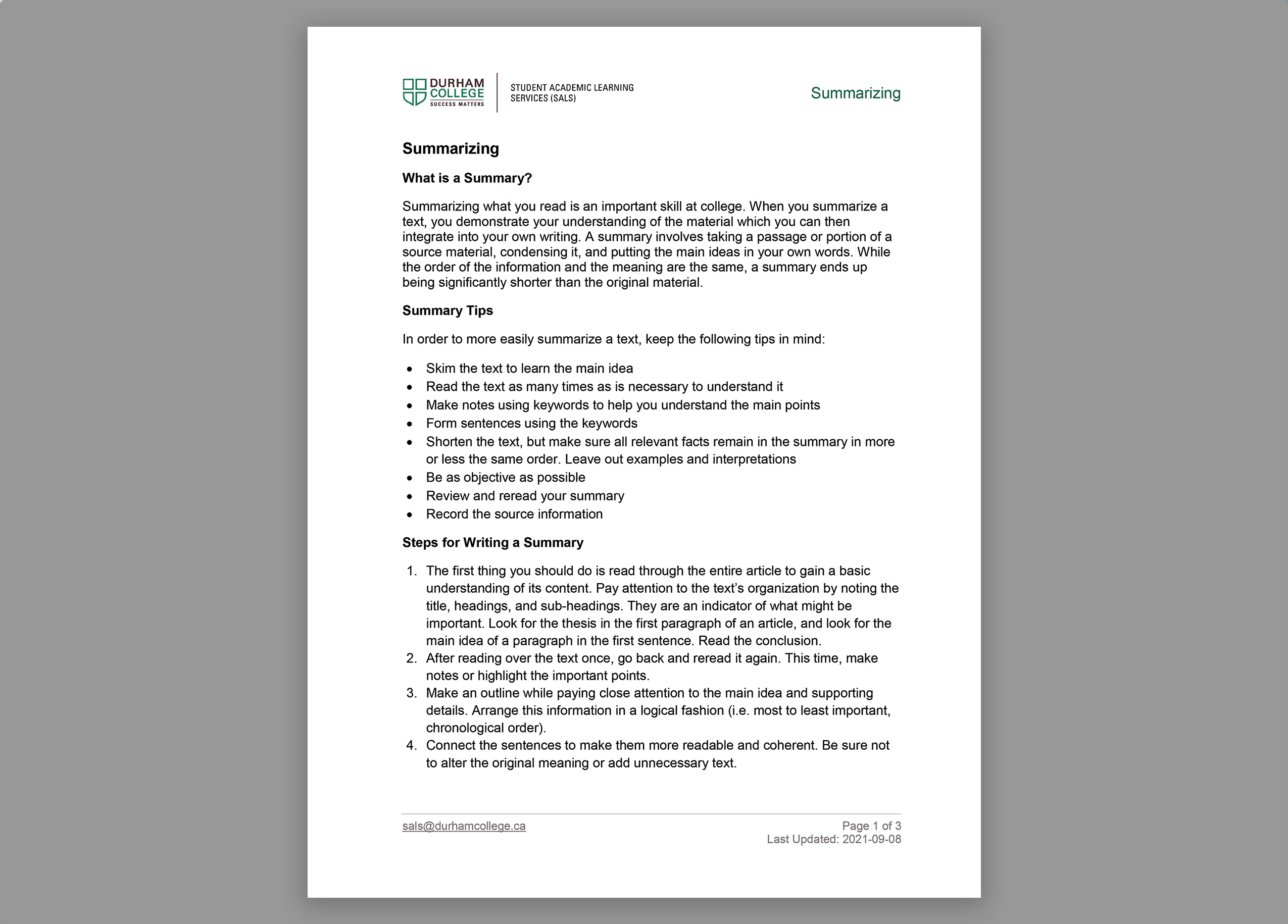Tips

Welcome to the tips page. We hope these tips and definitions help you become a Write It Again pro.

Direct Quotes
Using quotations strategically and introducing them correctly will lead to a more coherent and structured document and will make using MLA or APA citation style much easier.

Paraphrasing
Strong academic and professional writers use various methods to incorporate findings and information from other sources to effectively communicate their own ideas.

Summarizing
Summarizing what you read is an important skill at college. When you summarize a text, you demonstrate your understanding of the material which you can then integrate into your own writing.
Tips & Definitions
Tips
Follow the steps carefully and when you are finished, use the Summarizing Checklist.
Steps for Writing a Summary
- Skim the text to learn the main idea. Pay attention to the text’s organization by noting the title, headings, and sub-headings. Look for the main idea of a paragraph in the first sentence.
- Read the text again to get a good sense of its meaning.
- Use a dictionary to look up any new or difficult words. Use a thesaurus to find a synonym for the new words.
- Make point form notes, using key words, to help you understand the key point(s).
- Re-read the original. Make sure your point form notes capture the essential information.
- Without looking at the original, use your point form notes to write differently structured sentences.
- Include only the main idea(s). Leave out examples and interpretations.
- Check your work for correct grammar, spelling, and punctuation.
- Reference the source in text and on a Works Cited/References page.
Summarizing Checklist
- Did I read the material until I had a good understanding of its meaning?
- Did I look up difficult words in a dictionary and use a thesaurus to find synonyms for those words?
- Did I write point form notes to capture the main idea(s) from the original?
- Did I compare my notes against the original to make sure I noted the key information?
- Did I rewrite the sentences without looking at the original?
- Do my sentences have a different structure and different vocabulary than the original?
- Did I retain the main idea from the original and leave out examples and interpretations? Is my summary much shorter than the original?
- Did I check my summary for correct grammar, spelling, and punctuation?
- Did I reference the material both in text and in a References/Works Cited page at the end of my document?
Follow the steps carefully and when you are finished, use the Paraphrasing Checklist.
Steps for Writing a Paraphrase
- Read the text several times to get a good sense of its meaning.
- Use a dictionary to look up any new or difficult words. Use a thesaurus to find a synonym for the new words.
- Make point forms notes about the content of the material.
- Re-read the original. Make sure your point form notes capture the essential information.
- Without looking at the original, use your point form notes to write differently structured sentences.
- Check your paraphrase against the original to ensure that the structure of the sentences and the vocabulary are different but that the meaning is the same.
- Check your work for correct grammar, spelling, and punctuation.
- Reference the source in text and on a Works Cited/References page.
Paraphrasing Checklist
- Did I read the material until I had a good understanding of its meaning?
- Did I look up difficult words in a dictionary and use a thesaurus to find synonyms for those words?
- Did I write point form notes to capture the information from the original?
- Did I compare my notes against the original to make sure I noted the key information?
- Did I rewrite the sentences without looking at the original?
- Do my sentences have a different structure and different vocabulary than the original?
- Did I retain the meaning from the original? Is my paraphrase about the same length as the original?
- Did I check my paraphrase for correct grammar, spelling, and punctuation?
- Did I reference the material both in text and in a Works Cited/References page at the end of my document?
Follow the steps carefully and when you are finished, use the quotation checklist.
Steps for Using a Direct Quotation
- Read the text to get a good sense of its meaning.
- Use enough of the quotation so that the original context is clear.
- State where the quotation is from.
- Introduce the quotation by using a synonym of ‘says’ (i.e. argues, concludes, explains, proposes, states, suggests), when possible.
- Keep the author’s words exactly the same as in the original.
- Use quotation marks around the entire quotation.
- Reference the source in text and on a Works Cited/References page.
Quotation Checklist
- Did I read the material until I had a good understanding of its meaning?
- Did I use enough of the quotation so that the original context is clear?
- Did I clearly state where the quotation came from before I included the quotation?
- Did I use a synonym of ‘says’ to introduce the quotation, when possible?
- Did I keep the author’s words exactly the same as in the original?
- Did I use quotation marks around the entire quotation?
- Did I reference the material both in text and in a Works Cited/References page at the end of my document?
Definitions
APA* is a format style used to reference/cite someone else’s words or ideas. Usually, APA is the format used in health, science, and technology studies. Ask your professor whether or not you should be using APA or MLA to reference or cite your research paper or essay.
When you use APA, you indicate where you got your researched information by including an in-text citation and a longer reference on a "References" page.
The APA in-text citation usually includes the author’s last name and the year the information was published, e.g. (Smith, 2020), but can vary depending on the source. The APA reference listing on the "References" page follows a format which varies depending on the type of source and other factors.
Just check the APA Reference Guide (7th edition) at the Durham College library to find out how to correctly format your in-text citations and the "References" page.
* APA = "American Psychological Association"
You use an in-text citation when you are referencing or citing researched information in a paper, essay, or presentation. Every time you use someone else’s ideas or words, you include an in-text citation, so that the reader quickly knows where the information came from. In-text citations are sometimes called "parenthetical references". The in-text citation:
- is very short and is usually placed in brackets (parentheses) at the end of the sentence or paragraph of cited information
- matches a longer reference at the end of the document on a Works Cited page or References page
- usually includes the author’s last name and the page number when you are using the MLA format – e.g. (Smith 63)
- usually includes the author’s last name and the year the information was published when you are using the APA format - e.g. (Smith, 2020)
MLA* is a format style used to reference/cite someone else’s words or ideas. Usually, MLA is the format used in arts, business, and humanities studies. Ask your professor whether or not you should be using MLA or APA to reference or cite your research paper or essay.
When you use MLA, you indicate where you got your researched information by including an in-text citation and a longer reference on a "Works Cited" page.
The MLA in-text citation usually includes the author’s last name and the page number, e.g. (Smith 63), but can vary depending on the source. The MLA reference listing on the "Works Cited" page follows a format which varies depending on the type of source and other factors.
Just check the MLA Reference Guide (9th edition) at the Durham College library to find out how to correctly format your in-text citations and the "Works Cited" page.
* MLA = "Modern Language Association"
Plagiarism is the act of using someone else’s words or ideas without indicating where the information came from. You can avoid plagiarism by referencing or citing.
If you plagiarize at Durham College, you can lose marks, lose a credit, or even be dismissed from the college. Read the Academic Integrity Policy to find out more, or ask your professor or Student Advisor.
If you’re still not sure what academic integrity means to you, complete the Academic Integrity learning module in the SALS ONLINE Academic Integrity unit and/or visit the Academic Integrity materials within the Learning Resources section of MyDC.
When you "reference" or "cite" (the words mean almost the same thing), you indicate exactly where you found the information you are using in your paper, essay, or presentation. This helps you avoid plagiarism.
You show where you found your researched information by including an in-text citation right beside your researched information AND by including a complete reference on a Works Cited page or References page at the end of your document.
For APA citation only:
The "References" page lists all the sources you cited for your report or essay, and usually is placed at the end of your document. You use a "References" page when you are using the APA format to reference or cite your research.
Every source listed on the "References" page should have at least one corresponding in-text citation in your document.
Use the APA Reference Guide (7th edition) at the Durham College library to find out how to correctly format your "References" page and your APA in-text citations.
A thesaurus is a book that lists words in groups of synonyms (words that mean the same thing) and related concepts. You can also find thesauruses online.
Using a thesaurus to find synonyms of words will help you to summarize and paraphrase more effectively and help you avoid repetition in your writing.
For MLA citation only:
The "Works Cited" page lists all the sources you cited for your report or essay, and usually is placed at the end of your document. You use a "Works Cited" page when you are using the MLA format to reference or cite your research.
Usually, every source listed on the "Works Cited" page should have at least one corresponding in-text citation in your document.
Use the MLA Reference Guide (9th edition) at the Durham College library to find out how to correctly format your "Works Cited" page and your MLA in-text citations.